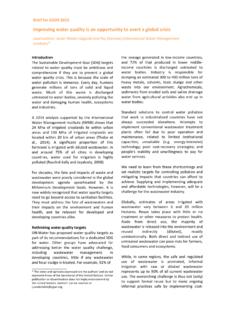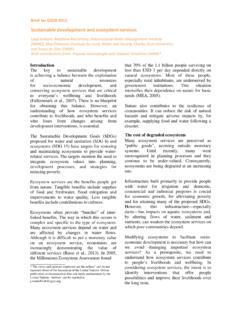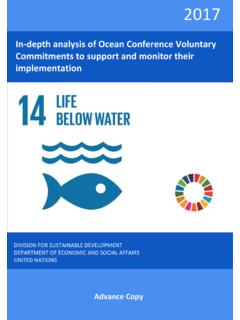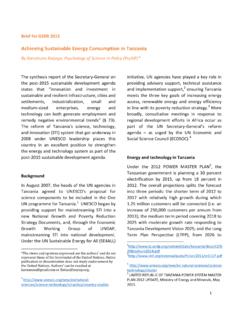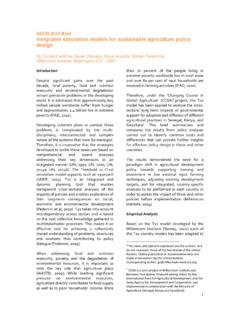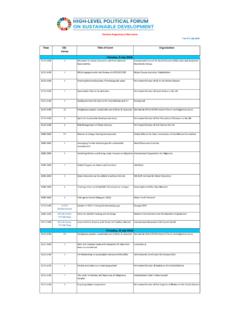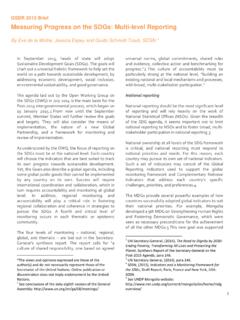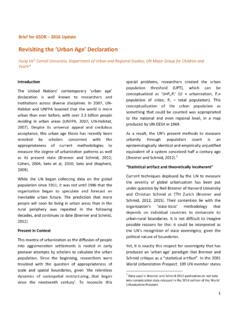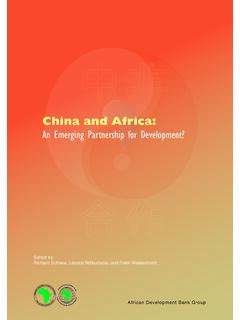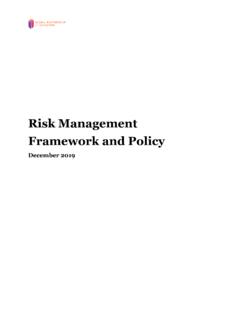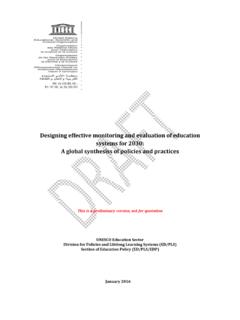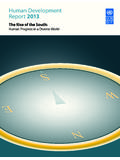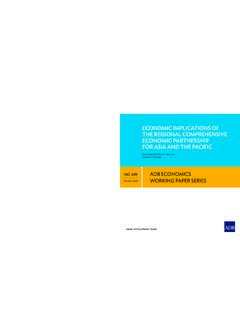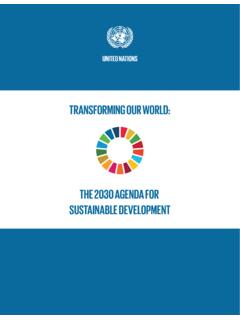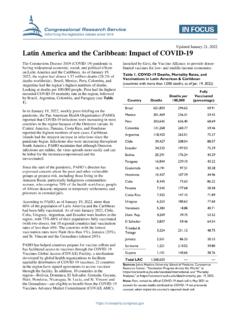Transcription of THE SDG PARTNERSHIP GUIDEBOOK - United Nations
1 THE SDG PARTNERSHIP GUIDEBOOKA practical guide to building high impact multi-stakeholder partnerships for the Sustainable development GoalsFirst EditionTHE SDG PARTNERSHIP GUIDEBOOKC itation: THE SDG PARTNERSHIP GUIDEBOOK : A practical guide to building high-impact multi-stakeholder partnerships for the Sustainable development Goals, Darian Stibbe and Dave Prescott, The Partnering Initiative and UNDESA 2020 Design: Alison BeanlandCover: Ola GoranssonCopyright 2020: United Nations and The Partnering InitiativeNote: The views expressed in the GUIDEBOOK are those of the authors and do not necessarily reflect those of the two publication is a joint effort of the United Nations and The Partnering Initiative as part of the 2030 Agenda PARTNERSHIP Accelerator, with a generous funding contribution from the United Nations Office for Sustainable development (UNOSD).
2 Lead authors: Darian Stibbe, Dave Prescott, with significant input from Ruth Findlay Brooks and Julia Gilbert (The Partnering Initiative, TPI), and Ola Goransson ( United Nations Department of Economic and Social Affairs, UN DESA).The drafting also benefitted from a global review process undertaken by TPI, with input provided by (in alphabetical order) Fernando Casado, Jenny Ekelund, Todd Kirkbride, Aitor Llodio, Mathewos Muke, Jo Pyres, Liv Raphael, Sarita Sehgal, Herbert Smorenberg, Thom Sprenger, Shani Tiran and Mike Wisheart. We would also like to thank Ian de Villiers and Mike Wisheart for many discussions on partnering over the years which helped to formulate some of the theory presented here.
3 2030 Agenda PARTNERSHIP AcceleratorThe 2030 Agenda PARTNERSHIP Accelerator is a collaborative initiative of the Division for Sustainable development Goals (DSDG) of United Nations Department of Economic and Social Affairs (UN DESA) and The Partnering Initiative (TPI), in collaboration with United Nations Office for Sustainable development , United Nations Office for Partnerships, UN global Compact, and the UN development Coordination Office. The initiative aims to significantly help accelerate and scale up effective partnerships in support of the 2030 Agenda for Sustainable : SDG PARTNERSHIP GUIDEBOOKPART ONE: Setting the scene 51 Using this guide 62 Partnering to maximise SDG Impact 103 Business as a key development actor and partner 14 PART TWO: Defining terms, understanding the landscape 224 Defining and categorising partnerships 235 Understanding different stakeholders 256 How do partnerships create value?
4 34 PART THREE: Designing and implementing a PARTNERSHIP 377 The partnering process 388 The PARTNERSHIP formation journey 409 Building Blocks of effective partnerships 44 BB1. Fundamentals 46 BB2. PARTNERSHIP relationship 49 BB3. Structure and set-up 54 BB4. Management and leadership 57 PART FOUR: Annexes 64 Annex 1: Institutional capacity to partner 65 Annex 2: Some implications of country context on partnering 78 Annex 3: Partnerships for transformational development 70 Tools 79 Tool 1: Stakeholder mapping 80 Tool 2: Partnering agreement template 81 Tool 3: Internal prospective PARTNERSHIP assessment 82 Tool 4: Value assessment framework 84 Tool 5: Troubleshooting 86 Tool 6: Managing power imbalances 88 Tool 7.
5 Partnering healthcheck 91In this guide4 SETTING THE SCENETHE SDG PARTNERSHIP GUIDEBOOKG uidebook leadsThe Partnering InitiativeThe Partnering Initiative (TPI) is a leading international NGO, dedicated to unleashing the power of PARTNERSHIP for a prosperous and sustainable future. TPI has been a pioneer in the development of the theory and practice of multi-stakeholder collaboration since it was founded in 2003, when it published its first, seminal partnering toolkit, translated into eleven languages and republished three times. TPI continues to drive and codify the state-of-the-art of effective PARTNERSHIP practice while building up the PARTNERSHIP -enabling eco-system through: training individuals; supporting organisations to become institutionally fit for partnering; supporting the strategy, development , evaluation and best practice guidance for partnerships; building in-country platforms to catalyse PARTNERSHIP and inputting into international policy development .
6 UN DESA UN DESA is a vital interface between global policies and national action in the economic, social and environmental spheres. Rooted in the United Nations Charter and guided by the universal and transformative 2030 Agenda for Sustainable development and other global agreements, UN DESA responds to the needs and priorities of the global the PARTNERSHIP AcceleratorPartnership Enabling Eco-systemABOUT THIS GUIDEThe 2030 Agenda PARTNERSHIP Accelerator is a collaborative initiative of United Nations Department of Economic and Social Affairs (UN DESA) and The Partnering Initiative (TPI), in collaboration with United Nations Office for Partnerships, UN global Compact, and the UN development Coordination Office.
7 The PARTNERSHIP Accelerator aims to develop the PARTNERSHIP -enabling ecosystem (see above) which can support the engagement of business as a partner in sustainable development and accelerate the number and effectiveness of partnerships towards delivering the 2030 Agenda. Its aims are to:1 Raise understanding and build the partnering skills and competencies of UN and government staff, alongside NGO and business counterparts; this will result in far faster PARTNERSHIP development and the creation of more robust, effective partnerships;2 Support the organizational change required for our institutions to become fit for partnering , enabling them to optimize the way they work and thus deliver more through far more efficient and effective partnering.
8 3 Draw out good practice and support the development of efficient SDG PARTNERSHIP platforms around the world, thereby creating the mechanism through which governments and the UN can systematically engage, and partner, with business and other development actors. In recognition of the urgency of the 2030 Agenda, the Decade of Action calls for accelerating sustainable solutions to all the world s biggest challenges ranging from poverty and gender to climate change, inequality and closing the finance September 2019, the UN Secretary-General called on all sectors of society to mobilize for a decade of action on three levels: global action to secure greater leadership, more resources and smarter solutions for the Sustainable development Goals; local action embedding the needed transitions in the policies, budgets, institutions and regulatory frameworks of governments, cities and local authorities.
9 And people action, including by youth, civil society, the media, the private sector, unions, academia and other stakeholders, to generate an unstoppable movement pushing for the required GUIDEBOOK aims to support the development of partnerships that can contribute to the Decade of with partnering knowledge and skillsOrganisations that are fit for partneringPartnerships built to good practice standardsNational and international policy supportive of collaboration Platforms/ mechanisms to systematically catalyse partnershipsMODULE 1 THE SDG PARTNERSHIP GUIDEBOOK15 Setting the sceneMODULE 1 MODULE 2 MODULE 3 Using the guide 6 Partnering to maximise SDG impact 10 Business as a key development actor and partner 14 6 SETTING THE SCENETHE SDG PARTNERSHIP GUIDEBOOKU sing the guide
10 It is the long history of humankind that those who learned to collaborate and improvise most effectively have prevailed. Charles DarwinThe aim of this GUIDEBOOK is to convey the magic of how multi-stakeholder partnerships at country level can deliver extraordinary results towards the Sustainable development Goals and provide clear guidance on how to build the most robust, effective collaborations. The GUIDEBOOK sets out the key Building Blocks of successful partnerships and the underlying processes from initial stakeholder engagement to PARTNERSHIP review necessary to develop and keep those Building Blocks in place and to maximise PARTNERSHIP impact. Along with frameworks to help organisations understand, identify and select the most appropriate forms of collaboration, the GUIDEBOOK includes a series of tools that support organisations through each step of PARTNERSHIP development and management.

